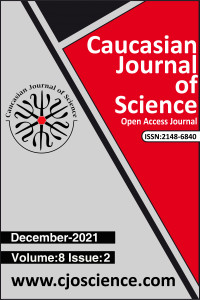Öz
Kaynakça
- Lillie, P. J., Samson, A., Li, A., Adams, K., Capstick, R., Barlow, G. D., Easom, N., Hamilton, E., Moss, P. J., Evans, A., Ivan, M., Taha, Y., Duncan, C. J. A., & Schmid, M. L., & The Airborne HCID Network, PHE Incident Team. (2020). Novel coronavirus disease (Covid-19): The first two patients in the UK with person to person transmission. Journal of Infection, 80, 578–606. https://doi.org/10.1016/j.jinf.2020.02.020
- Lai, C. C., Liu, Y. H., Wang, C. Y., Wang, Y. H., Hsueh, S. C., Yen, M. Y., Chien Ko, W., & Hsueh, P. R. (2020). Asymptomatic carrier state, acute respiratory disease, and pneumonia due to severe acute respiratory syndrome coronavirus 2 (SARS-CoV-2): Facts and myths. Journal of Microbiology, Immunology and Infection, 53(3), 404-412. https://doi.org/10.1016/j.jmii.2020.02.012
- De Wit, E., Van Doremalen, N., Falzarano, D., & Munster, V. J. (2016). SARS and MERS: recent insights into emerging coronaviruses. Nature Reviews Microbiology, 14(8), 523-534. https://doi.org/10.1038/nrmicro.2016.81
- Wu, J. T., Leung, K., & Leung, G. M. (2020). Nowcasting and forecasting the potential domestic and international spread of the 2019-nCoV outbreak originating in Wuhan, China: a modelling study. The Lancet, 395(10225), 689-697. https://doi.org/10.1016/S0140-6736(20)30260-9
- Yan, S., Sun, H., Bu, X., & Wan, G. (2020). New strategy for COVID-19: an evolutionary role for RGD motif in SARS-CoV-2 and potential inhibitors for virus infection. Frontiers in Pharmacology, 11, 912. https://doi.org/10.3389/fphar.2020.00912
- Van Der Hoek, L., Pyrc, K., Jebbink, M. F., Vermeulen-Oost, W., Berkhout, R. J., Wolthers, K. C., & Berkhout, B. (2004). Identification of a new human coronavirus. Nature medicine, 10(4), 368-373. https://doi.org/10.1038/nm1024
- Zheng, J. (2020). SARS-CoV-2: an emerging coronavirus that causes a global threat. International journal of biological sciences, 16(10), 1678. 10.7150/ijbs.45053
- Hilgenfeld, R. (2014). From SARS to MERS: crystallographic studies on coronaviral proteases enable antiviral drug design. The FEBS journal, 281(18), 4085-4096. https://doi.org/10.1111/febs.12936
- Ortega, J. T., Serrano, M. L., Pujol, F. H., & Rangel, H. R. (2020). Unrevealing sequence and structural features of novel coronavirus using in silico approaches: The main protease as molecular target. EXCLI journal, 19, 400. http://dx.doi.org/10.17179/excli2020-1189
- Jin, Z., Du, X., Xu, Y., Deng, Y., Liu, M., Zhao, Y., & Yang, H. (2020). Structure of M pro from SARS-CoV-2 and discovery of its inhibitors. Nature, 582(7811), 289-293. https://doi.org/10.1038/s41586-020-2223-y
- El-Shazly, A., Abdel-Ghani, A., & Wink, M. (2003). Pyrrolizidine alkaloids from Onosma arenaria (Boraginaceae). Biochemical Systematics and Ecology, 31(5), 477-485. https://doi.org/10.1016/S0305-1978(02)00177-1
- Binzet, R. (2009). Anatomical and palynological investigations on endemic Onosma mersinana Riedl, Binzet & Orcan. Pakistan Journal of Botany, 41, 503-510.
- Ozgen, U., Miloglu, F. D., & Bulut, G. (2011). Quantitative determination of shikonin derivatives with UV-Vis spectrophotometric methods in the roots of Onosma nigricaule. Reviews in Analytical Chemistry, 30(2), 59-63. https://doi.org/10.1515/revac.2011.014
- Kagramanyan, N. S., & Mnatsakanyan, V. A. (1985). Shikonin and its derivatives from Onosma setosum roots. Armyanskii Khimicheskii Zhurnal, 38(8), 527-8.
- Sut, S., Pavela, R., Kolarčik, V., Cappellacci, L., Petrelli, R., Maggi, F., & Benelli, G. (2017). Identification of Onosma visianii roots extract and purified shikonin derivatives as potential acaricidal agents against Tetranychus urticae. Molecules, 22(6), 1002. https://doi.org/10.3390/molecules22061002
- Ozgen, U., Ikbal, M., Hacimuftuoglu, A., Houghton, P. J., Gocer, F., Dogan, H., & Coskun, M. (2006). Fibroblast growth stimulation by extracts and compounds of Onosma argentatum roots. Journal of ethnopharmacology, 104(1-2), 100-103. https://doi.org/10.1016/j.jep.2005.08.052
- Schrödinger Release 2020-3: Maestro, Schrödinger, LLC, New York, NY, 2020
- Kılınç, N. Inhibition profiles and molecular docking studies of antiproliferative agents against aldose reductase enzyme. International Journal of Chemistry and Technology, 5(1), 77-82. https://doi.org/10.32571/ijct.944049
- Genheden, S.; Ryde, U. (2015) The MM/PBSA and MM/GBSA methods to estimate ligand-binding affinities. Expert Opinion on Drug Discovery, 10(5), 449-461. https://doi.org/10.1517/17460441.2015.1032936
- Oladele, J. O., Ajayi, E. I., Oyeleke, O. M., Oladele, O. T., Olowookere, B. D., Adeniyi, B. M., & Oladiji, A. T. (2020). A systematic review on COVID-19 pandemic with special emphasis on curative potentials of Nigeria based medicinal plants. Heliyon, e04897. https://doi.org/10.1016/j.heliyon.2020.e04897
- Tada, M., Okuno, K., Chiba, K., Ohnishi, E., & Yoshii, T. (1994). Antiviral diterpenes from Salvia officinalis. Phytochemistry, 35(2), 539-541. https://doi.org/10.1016/S0031-9422(00)94798-8
- Koch, C., Reichling, J., Kehm, R., Sharaf, M. M., Zentgraf, H., Schneele, J., & Schnitzler, P. (2008). Efficacy of anise oil, dwarf‐pine oil and chamomile oil against thymidine‐kinase‐positive and thymidine‐kinase‐negative herpesviruses. Journal of Pharmacy and Pharmacology, 60(11), 1545-1550. https://doi.org/10.1211/jpp.60.11.0017
- Mukhtar, M., Arshad, M., Ahmad, M., Pomerantz, R. J., Wigdahl, B., & Parveen, Z. (2008). Antiviral potentials of medicinal plants. Virus research, 131(2), 111-120. https://doi.org/10.1016/j.virusres.2007.09.008
- Tan, W. C., Jaganath, I. B., Manikam, R., & Sekaran, S. D. (2013). Evaluation of antiviral activities of four local Malaysian Phyllanthus species against herpes simplex viruses and possible antiviral target. International Journal of Medical Sciences, 10(13), 1817. 10.7150/ijms.6902
- Mikaili, P., Maadirad, S., Moloudizargari, M., Aghajanshakeri, S., & Sarahroodi, S. (2013). Therapeutic uses and pharmacological properties of garlic, shallot, and their biologically active compounds. Iranian journal of basic medical sciences, 16(10), 1031.
- Theisen, L. L., & Muller, C. P. (2012). EPs® 7630 (Umckaloabo®), an extract from Pelargonium sidoides roots, exerts anti-influenza virus activity in vitro and in vivo. Antiviral research, 94(2), 147-156. https://doi.org/10.1016/j.antiviral.2012.03.006
- Yu, M. S., Lee, J., Lee, J. M., Kim, Y., Chin, Y. W., Jee, J. G., & Jeong, Y. J. (2012). Identification of myricetin and scutellarein as novel chemical inhibitors of the SARS coronavirus helicase, nsP13. Bioorganic & medicinal chemistry letters, 22(12), 4049-4054. https://doi.org/10.1016/j.bmcl.2012.04.081
- Zandi, K., Teoh, B. T., Sam, S. S., Wong, P. F., Mustafa, M. R., & AbuBakar, S. (2012). Novel antiviral activity of baicalein against dengue virus. BMC complementary and alternative medicine, 12(1), 1-9. https://doi.org/10.1186/1472-6882-12-214
- Andújar, I., Ríos, J. L., Giner, R. M., & Recio, M. C. (2013). Pharmacological properties of shikonin–a review of literature since 2002. Planta medica, 79(18), 1685-1697. 10.1055/s-0033-1350934
- Chen, X., Yang, L., Zhang, N., Turpin, J. A., Buckheit, R. W., Osterling, C., & Howard, O. Z. (2003). Shikonin, a component of Chinese herbal medicine, inhibits chemokine receptor function and suppresses human immunodeficiency virus type 1. Antimicrobial agents and chemotherapy, 47(9), 2810-2816. https://doi.org/10.1128/AAC.47.9.2810-2816.2003
Naphthoquinones from Onosma: Molecular Mechanisms of Action in the Treatment and Prevention of COVID-19
Öz
Absrtact
COVID-19, which is caused by the severe acute respiratory syndrome coronavirus 2 (SARS-CoV-2), first detected in December 2019 in Wuhan, China. There is currently no effective treatment or immunization for the virus, and it is spreading rapidly with a high mortality rate. As a crucial CoV enzyme involved in initiating both viral replication and transcription, the COVID-19 main protease (Mpro) is an appealing target for researchers. Novel therapeutics are urgently required to treat the early stages of COVID-19 caused by SARS-CoV-2. Therefore, to find potential COVID-19 Mpro inhibitors, naphthoquinones from the Onosma genus were screened to find out their possible effects on the Mpro enzyme. In this study, we employed a range of computational approaches, including molecular docking and MM-GBSA, to uncover potential inhibitors of SARS-CoV-2 Mpro from existing natural product databases. According to our findings, the molecules deoxyshikonin, 3-hydroxy-isovalerylshikonin, propionylshikonin, and acetylshikonin have high binding affinities for the Mpro enzyme. In addition, it was observed that the other shikonin compounds have anti-Mpro enzyme activity. Docking simulations and molecular mechanics suggest that shikonin derivatives might be effective anti-SARS-CoV-2 compounds.
Anahtar Kelimeler
Kaynakça
- Lillie, P. J., Samson, A., Li, A., Adams, K., Capstick, R., Barlow, G. D., Easom, N., Hamilton, E., Moss, P. J., Evans, A., Ivan, M., Taha, Y., Duncan, C. J. A., & Schmid, M. L., & The Airborne HCID Network, PHE Incident Team. (2020). Novel coronavirus disease (Covid-19): The first two patients in the UK with person to person transmission. Journal of Infection, 80, 578–606. https://doi.org/10.1016/j.jinf.2020.02.020
- Lai, C. C., Liu, Y. H., Wang, C. Y., Wang, Y. H., Hsueh, S. C., Yen, M. Y., Chien Ko, W., & Hsueh, P. R. (2020). Asymptomatic carrier state, acute respiratory disease, and pneumonia due to severe acute respiratory syndrome coronavirus 2 (SARS-CoV-2): Facts and myths. Journal of Microbiology, Immunology and Infection, 53(3), 404-412. https://doi.org/10.1016/j.jmii.2020.02.012
- De Wit, E., Van Doremalen, N., Falzarano, D., & Munster, V. J. (2016). SARS and MERS: recent insights into emerging coronaviruses. Nature Reviews Microbiology, 14(8), 523-534. https://doi.org/10.1038/nrmicro.2016.81
- Wu, J. T., Leung, K., & Leung, G. M. (2020). Nowcasting and forecasting the potential domestic and international spread of the 2019-nCoV outbreak originating in Wuhan, China: a modelling study. The Lancet, 395(10225), 689-697. https://doi.org/10.1016/S0140-6736(20)30260-9
- Yan, S., Sun, H., Bu, X., & Wan, G. (2020). New strategy for COVID-19: an evolutionary role for RGD motif in SARS-CoV-2 and potential inhibitors for virus infection. Frontiers in Pharmacology, 11, 912. https://doi.org/10.3389/fphar.2020.00912
- Van Der Hoek, L., Pyrc, K., Jebbink, M. F., Vermeulen-Oost, W., Berkhout, R. J., Wolthers, K. C., & Berkhout, B. (2004). Identification of a new human coronavirus. Nature medicine, 10(4), 368-373. https://doi.org/10.1038/nm1024
- Zheng, J. (2020). SARS-CoV-2: an emerging coronavirus that causes a global threat. International journal of biological sciences, 16(10), 1678. 10.7150/ijbs.45053
- Hilgenfeld, R. (2014). From SARS to MERS: crystallographic studies on coronaviral proteases enable antiviral drug design. The FEBS journal, 281(18), 4085-4096. https://doi.org/10.1111/febs.12936
- Ortega, J. T., Serrano, M. L., Pujol, F. H., & Rangel, H. R. (2020). Unrevealing sequence and structural features of novel coronavirus using in silico approaches: The main protease as molecular target. EXCLI journal, 19, 400. http://dx.doi.org/10.17179/excli2020-1189
- Jin, Z., Du, X., Xu, Y., Deng, Y., Liu, M., Zhao, Y., & Yang, H. (2020). Structure of M pro from SARS-CoV-2 and discovery of its inhibitors. Nature, 582(7811), 289-293. https://doi.org/10.1038/s41586-020-2223-y
- El-Shazly, A., Abdel-Ghani, A., & Wink, M. (2003). Pyrrolizidine alkaloids from Onosma arenaria (Boraginaceae). Biochemical Systematics and Ecology, 31(5), 477-485. https://doi.org/10.1016/S0305-1978(02)00177-1
- Binzet, R. (2009). Anatomical and palynological investigations on endemic Onosma mersinana Riedl, Binzet & Orcan. Pakistan Journal of Botany, 41, 503-510.
- Ozgen, U., Miloglu, F. D., & Bulut, G. (2011). Quantitative determination of shikonin derivatives with UV-Vis spectrophotometric methods in the roots of Onosma nigricaule. Reviews in Analytical Chemistry, 30(2), 59-63. https://doi.org/10.1515/revac.2011.014
- Kagramanyan, N. S., & Mnatsakanyan, V. A. (1985). Shikonin and its derivatives from Onosma setosum roots. Armyanskii Khimicheskii Zhurnal, 38(8), 527-8.
- Sut, S., Pavela, R., Kolarčik, V., Cappellacci, L., Petrelli, R., Maggi, F., & Benelli, G. (2017). Identification of Onosma visianii roots extract and purified shikonin derivatives as potential acaricidal agents against Tetranychus urticae. Molecules, 22(6), 1002. https://doi.org/10.3390/molecules22061002
- Ozgen, U., Ikbal, M., Hacimuftuoglu, A., Houghton, P. J., Gocer, F., Dogan, H., & Coskun, M. (2006). Fibroblast growth stimulation by extracts and compounds of Onosma argentatum roots. Journal of ethnopharmacology, 104(1-2), 100-103. https://doi.org/10.1016/j.jep.2005.08.052
- Schrödinger Release 2020-3: Maestro, Schrödinger, LLC, New York, NY, 2020
- Kılınç, N. Inhibition profiles and molecular docking studies of antiproliferative agents against aldose reductase enzyme. International Journal of Chemistry and Technology, 5(1), 77-82. https://doi.org/10.32571/ijct.944049
- Genheden, S.; Ryde, U. (2015) The MM/PBSA and MM/GBSA methods to estimate ligand-binding affinities. Expert Opinion on Drug Discovery, 10(5), 449-461. https://doi.org/10.1517/17460441.2015.1032936
- Oladele, J. O., Ajayi, E. I., Oyeleke, O. M., Oladele, O. T., Olowookere, B. D., Adeniyi, B. M., & Oladiji, A. T. (2020). A systematic review on COVID-19 pandemic with special emphasis on curative potentials of Nigeria based medicinal plants. Heliyon, e04897. https://doi.org/10.1016/j.heliyon.2020.e04897
- Tada, M., Okuno, K., Chiba, K., Ohnishi, E., & Yoshii, T. (1994). Antiviral diterpenes from Salvia officinalis. Phytochemistry, 35(2), 539-541. https://doi.org/10.1016/S0031-9422(00)94798-8
- Koch, C., Reichling, J., Kehm, R., Sharaf, M. M., Zentgraf, H., Schneele, J., & Schnitzler, P. (2008). Efficacy of anise oil, dwarf‐pine oil and chamomile oil against thymidine‐kinase‐positive and thymidine‐kinase‐negative herpesviruses. Journal of Pharmacy and Pharmacology, 60(11), 1545-1550. https://doi.org/10.1211/jpp.60.11.0017
- Mukhtar, M., Arshad, M., Ahmad, M., Pomerantz, R. J., Wigdahl, B., & Parveen, Z. (2008). Antiviral potentials of medicinal plants. Virus research, 131(2), 111-120. https://doi.org/10.1016/j.virusres.2007.09.008
- Tan, W. C., Jaganath, I. B., Manikam, R., & Sekaran, S. D. (2013). Evaluation of antiviral activities of four local Malaysian Phyllanthus species against herpes simplex viruses and possible antiviral target. International Journal of Medical Sciences, 10(13), 1817. 10.7150/ijms.6902
- Mikaili, P., Maadirad, S., Moloudizargari, M., Aghajanshakeri, S., & Sarahroodi, S. (2013). Therapeutic uses and pharmacological properties of garlic, shallot, and their biologically active compounds. Iranian journal of basic medical sciences, 16(10), 1031.
- Theisen, L. L., & Muller, C. P. (2012). EPs® 7630 (Umckaloabo®), an extract from Pelargonium sidoides roots, exerts anti-influenza virus activity in vitro and in vivo. Antiviral research, 94(2), 147-156. https://doi.org/10.1016/j.antiviral.2012.03.006
- Yu, M. S., Lee, J., Lee, J. M., Kim, Y., Chin, Y. W., Jee, J. G., & Jeong, Y. J. (2012). Identification of myricetin and scutellarein as novel chemical inhibitors of the SARS coronavirus helicase, nsP13. Bioorganic & medicinal chemistry letters, 22(12), 4049-4054. https://doi.org/10.1016/j.bmcl.2012.04.081
- Zandi, K., Teoh, B. T., Sam, S. S., Wong, P. F., Mustafa, M. R., & AbuBakar, S. (2012). Novel antiviral activity of baicalein against dengue virus. BMC complementary and alternative medicine, 12(1), 1-9. https://doi.org/10.1186/1472-6882-12-214
- Andújar, I., Ríos, J. L., Giner, R. M., & Recio, M. C. (2013). Pharmacological properties of shikonin–a review of literature since 2002. Planta medica, 79(18), 1685-1697. 10.1055/s-0033-1350934
- Chen, X., Yang, L., Zhang, N., Turpin, J. A., Buckheit, R. W., Osterling, C., & Howard, O. Z. (2003). Shikonin, a component of Chinese herbal medicine, inhibits chemokine receptor function and suppresses human immunodeficiency virus type 1. Antimicrobial agents and chemotherapy, 47(9), 2810-2816. https://doi.org/10.1128/AAC.47.9.2810-2816.2003
Ayrıntılar
| Birincil Dil | İngilizce |
|---|---|
| Konular | Çevre Bilimleri |
| Bölüm | Caucasian Journal of Science |
| Yazarlar | |
| Yayımlanma Tarihi | 31 Aralık 2021 |
| Gönderilme Tarihi | 17 Aralık 2021 |
| Kabul Tarihi | 29 Aralık 2021 |
| Yayımlandığı Sayı | Yıl 2021 Cilt: 8 Sayı: 2 |
Cited By
An arsenal of naturopathic compounds for the treatment of COVID-19: A comprehensive review
Journal of Phytomoleculs and Pharmacology
https://doi.org/10.56717/jpp.2024.v03i01.023








